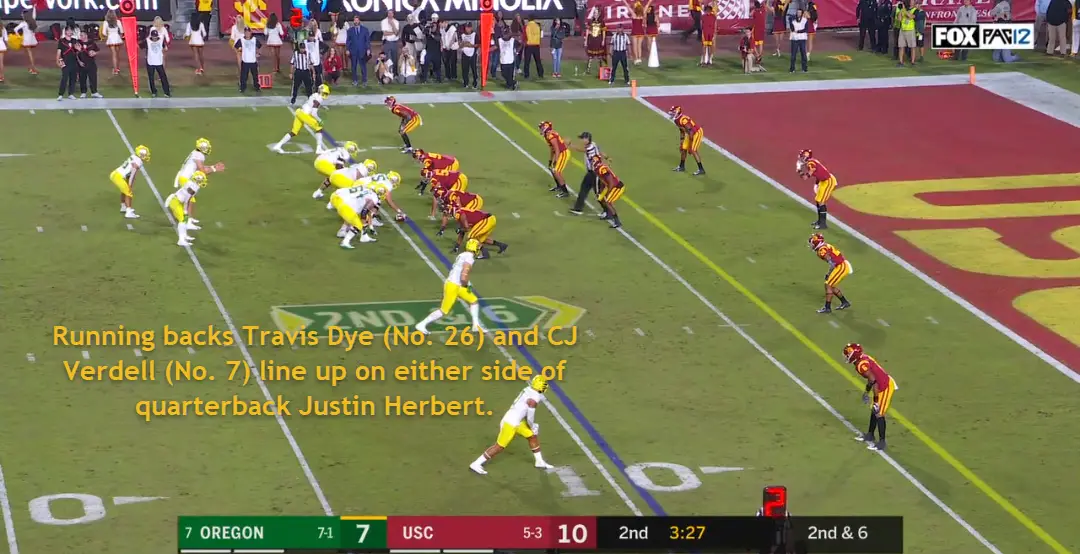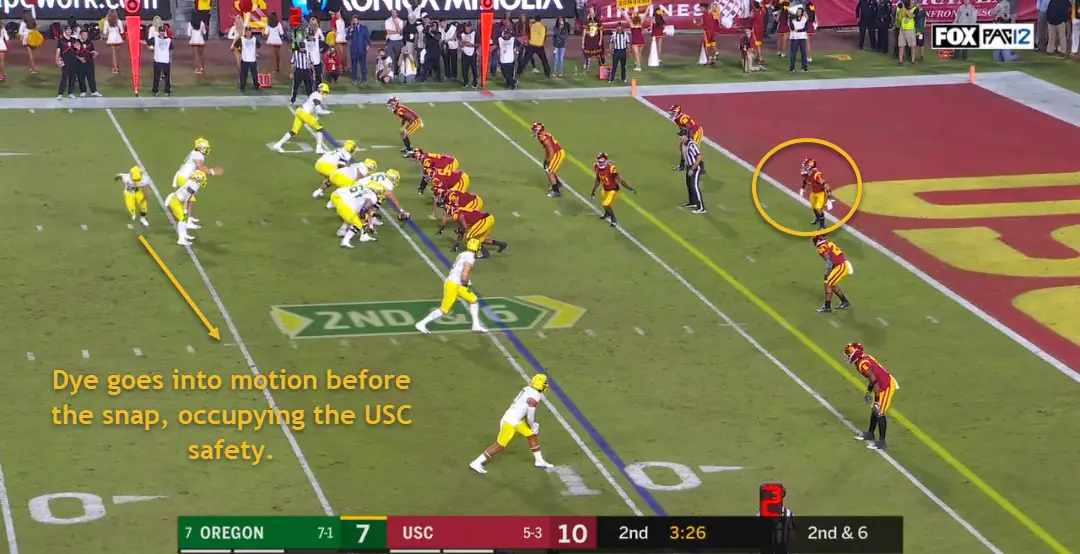Everybody loves an exciting, explosive spread-option offense. The Ducks had one of their own under Chip Kelly and Mark Helfrich, and many legendary offenses have thrived using this still-effective scheme.
However, with defenders becoming bigger, faster and stronger, and with the importance of having a healthy starting quarterback, head coaches of spread schemes now have to determine whether it’s worth the risk to continually run their quarterbacks. On the one hand, giving the quarterback the option to run gives an offense a numbers advantage, which is the ultimate goal of the spread. On the other hand, it exposes him to more hits, which means higher risk of injury.
Ever since Mario Cristobal and his staff took over at Oregon, they have taken the conservative approach, rarely running quarterback Justin Herbert, protecting him by any means possible. So, how do the Ducks gain a numbers advantage without running their quarterback? Offensive coordinator Marcus Arroyo has a couple of tricks up his sleeve, and one of them is an adaptation of a play the Ducks used during the days of Kelly to run up the score on opponents.
Arroyo’s Spin on the Triple Option
One of Oregon’s primary running plays under Kelly was the straddled triple option. Famously broken down by Mr. FishDuck himself, the straddled triple option is a play that has three options: an inside zone handoff, a speed option pitch, or a quarterback keep. It’s typically run from the splitback shotgun formation. Two running backs line up on either side of the quarterback, and the quarterback can hand it off to the one, pitch it to the other, or keep it himself.
The play is highly effective when run correctly, and it gashed many the Oregon foe in Kelly’s heyday. But it also exposes the quarterback to a bunch of hits. Under Cristobal’s regime, the straddled triple option has become a thing of the past for that reason. That is, until Arroyo revamped it with run-pass option (RPO) elements.

Oregon lines up in the splitback formation.
Against USC, the Ducks lined up in the same splitback formation (above) that Kelly used to terrorize Pac-12 defenses for years. With two of the Ducks’ best playmakers on either side of Herbert, the defense already has a lot to prepare for.

Dye’s motion moves the safety from the box.
Right before the snap (above), Herbert sends Travis Dye (No. 26) in a bubble motion. This instantly tips off the safety (circled above) that this is a potential bubble screen to Dye, who has a couple of blockers on the perimeter. The safety has to account for Dye, as otherwise the Ducks have a numbers advantage on the edge. This potential bubble screen is the first of the three options on this play, but with the safety committing to Dye, Oregon is outnumbered and decides to look elsewhere.

The defense commits to the run, the corner blitzes, and Johnson is wide open.
As the play unfolds (above), it’s clear that the second option on this play is an outside zone. USC knows that Oregon favors this play, especially from the offset shotgun, and its linebackers (solid yellow arrows above) crash hard on the run play.
At this point, it looks like the Trojans have snuffed out all of Oregon’s options. The bubble screen to Dye is accounted for, and the outside zone to CJ Verdell looks to be thwarted. But here’s where things get really interesting. At the last second, Herbert pulls the ball from Verdell’s gut and looks toward receiver Juwan Johnson (No. 6, circled in yellow above).
While the defense was ready for the relatively routine bubble screen/outside zone RPO, it wasn’t prepared for a third option: a playside stop route by the Ducks’ most physical receiver. With the defense committed to stopping the outside zone and paying no attention to Johnson (the cornerback initially lined up over Johnson blitzes, leaving Johnson with a big cushion against an overmatched safety), Herbert fires an easy completion to the transfer receiver, who gets a first down and nearly scores on the play.
This isn’t your father’s triple option in the sense that the quarterback isn’t zone-reading a defender. It’s a 21st-century, modernized version that works just as well. Standard RPOs, which usually include a primary passing option and a standard running play, are difficult enough to defend. But when a third option is added, all a defense can do is hope and pray that the offense makes the wrong read.
What’s more, this new-look triple option both protects the Ducks’ most valuable player and creates a numbers advantage for the offense. It’s truly a win-win, and it’s a play that Arroyo will likely pull out of his pocket a few more times as Oregon makes its playoff push.
Joshua Whitted
Morgantown, West VirginiaTop Photo by Eugene Johnson

Phil Anderson, the FishDuck.com Volunteer editor for this article, is a trial lawyer in Bend Oregon.
Joshua is an adopted Duck fanatic, originally hailing from southwestern Pennsylvania. His love for the University of Oregon began as a young child when he became mesmerized by the flashy uniforms and explosive offenses of the Chip Kelly era, and now, he follows the team religiously. His fondest memory of the team is seeing De’Anthony Thomas race past Wisconsin defenders back in the 2012 Rose Bowl. A true football enthusiast, Joshua loves studying the intricacies of the game, and he aspires to become a professional sports journalist. Joshua now resides in Morgantown, West Virginia where he works in customer service. When he’s not watching Oregon replays, Joshua loves reading, writing, and spending time with his family. Contact: whittedjd@gmail.com

